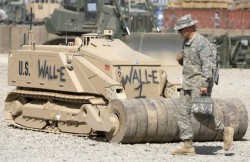 Weapon autonomy is a broad term around which swirls an incredible amount of debate. Paul Scharre, Michael Horowitz, and Adam Elkus join Sea Control to discuss the nature of autonomy, how to imagine its use in an operational environment, and how to think of the debate surrounding it.
Weapon autonomy is a broad term around which swirls an incredible amount of debate. Paul Scharre, Michael Horowitz, and Adam Elkus join Sea Control to discuss the nature of autonomy, how to imagine its use in an operational environment, and how to think of the debate surrounding it.
DOWNLOAD: Sea Control 92 -Autonomy
Music: Sam LaGrone
CIMSEC content is and always will be free; consider a voluntary monthly donation to offset our operational costs. As always, it is your support and patronage that have allowed us to build this community – and we are incredibly grateful.


Implicitly introduced in the discussion but not explicitly is the battle space involved and how much Autonomy you want to give your agent and the two examples brought up involve free fire zones of hundreds of miles in which civilian casualties were to be avoided but we’re not necessarily battle decision drivers.
When in fact what we’ve seen in the modern battle space is a mixture of civilian and military targets resulting in aggregious offenses against civilians mostly with the human operator on the loop.
When I create software I create an error rate by definition. That error rate is rarely explicitly communicated to the operator of the equipment.
Additionally, an autonomous system that has its decision space limited inherently creates vulnerabilities that are exploitable.
The more contact the opponent has with the system the more likely that these vulnerabilities will become known and exploited.
Yet this flys in the face of good systems design which above all else should be deterministic and predictable.